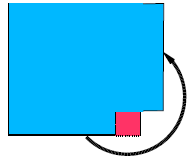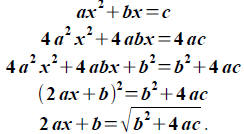Solving Polynomial Equations
Babylonians
Since the first half of the 19th Century, archeologists working in
Mesopotamia have unearthed some half-million inscribed clay
tablets. Many peoples and civilizations, among them the
Sumerians, Akkadians, Chaldeans, and Assyrians have inhabited
the area at one time or another. It is common practice to use the
term Babylonian to refer to all of them, even though the city of
Babylon was only prominent for a short period.
One of several types of quadratic problems that can be found in
the tablets are those of the form:
Given x + y = a and xy = c find x and y.
Geometrically, such problems are relating the perimeters of
rectangles to their areas, and this gives us a hint as to how they
might have obtained their solutions.
The problems in the clay tablets are, as with the Egyptian papyri,
always expressed with specific numbers, and the solutions are
obtained by following certain algorithms. Examining the algorithms
gives a reasonable explanation of a geometrical approach to their
solutions.
Thus, for the problems of the form x + y = b and xy = c, the
algorithm is:
1. Take the square of ½ b.
2. Subtract c from this value .
3. Take the square root of this value .
4. Add it to ½ b to get x and subtract it from ½ b to get y.
In modern terms, this algorithm is equivalent to what we call the
quadratic formula as taught in high school. We derive the formula
algebraically, but how did the Babylonians come up with it?
No one really knows how the Babylonians arrived at their
algorithm, and several suggestions have been made. Here is mine.
Problem: Find a rectangle whose area is c where the sum of the
two sides is b.
Solution: By the method of false position.
Let's guess that the answer is a square. The square would have
side ½b and area the square of this. Step 1: Square ½b.
Since this was a guess, the error made in terms of areas is the
difference between this value and c . Step 2: Subtract c.
A geometric square with area equal to this error would have a
side equal to the square root of the area. Step 3: Take square root.
We now have to adjust the sides of the square to get a rectangle
that has the right area. The procedure for this correction can be seen
from examining the following diagram.

Thus, the correct dimensions are obtained by adding the
side of
the error square to b/2 and subtracting it from b/2. Step 4.
Greek Solutions
The Greek geometers would easily find solutions of quadratic
equations geometrically. To solve x2 + bx + c = 0, they would in
principle find the intersection of the circle y = x2 with the line
y = bx + c by straightedge and compass constructions.
In Euclid's Elements, one finds a considerable amount of
discussion on whether or not the solutions are rational. This is
interesting because the issue is of no consequence in the geometric
constructions. It implies that the Greeks were concerned with
numerical solutions , since if the solutions were irrational they had
no way to represent them other than as lengths of line segments.
Hindu Solutions
There is evidence that the Hindu's may have been solving
quadratic equations as early as 200 B.C., but we have no record of
the methods used.
Brahmagupta (c. 628) gives the equation x2 – 10x = -9 and its
solution, showing that algorithms for the solutions of quadratics
were known by this time.
Śrīdhara (c. 1025) was the first, so far as known, to give the socalled
Hindu Rule for quadratics. He is quoted by Bhāskara
(c. 1150) as saying:
Multiply both sides of the equation by a number equal to four
times the [coefficient of the] square, and add to them a number
equal to the square of the original [coefficient of the] unknown
quantity. [Then extract the root.]
Thus, for the equation ax2 + bx = c we would get:

These Indian mathematicians worked with both positive and
negative numbers and had a symbol for zero . They worked
effectively with all types of numbers, but usually ignored any
negative roots of equations.
Al-Khwārizmī
One of the earliest Islamic algebra texts , written about 825 by
Muhammad ibn Mūsā al-Khwārizmī (c. 780-850) was titled
Al-kitāb al-muhtaşar fī hisāb al-jabr wa-l-muqābala
(The condensed book on the calculation of al-Jabr and al-Muqabala)
The term al-jabr can be translated as “restoring” and refers to
transposing a term from one side to the other of an equation. The
word al-muqabala is translated as “comparing” and refers to
subtracting equal quantities from both sides of an equation. Thus
3x + 2 = 4 – 2x => 5x + 2 = 4 is al-jabr while
5x + 2 = 4 => 5x = 2 is al-muqabala.
Our term “algebra” is a corrupted form of the Arabic al-jabr.
Al-Khwārizmī was interested in writing a practical guide to
solving equations, but due to the influence of Greek texts which
were being translated into arabic, he includes geometric
justifications of his manipulations. The geometry however appears
to come from the Babylonians rather than the Greeks.
He classifies the equations he will deal with into six types:
ax2 = bx  ax2 = c
ax2 = c
 bx = c
bx = c
ax2 + bx = c  ax2 + c = bx
ax2 + c = bx
 bx + c = ax2
bx + c = ax2
The reason for the six-fold classification is that Islamic
mathematicians, unlike the Hindus, did not deal with negative
numbers. In their system, coefficients, as well as the roots, had to
be positive. The types listed are the only ones with positive
solutions. [ax2 + bx + c = 0 would make no sense]
Viète 
François Viète (1540 – 1603) was a French lawyer who worked
for kings Henri III and Henri IV as a cryptanalyst (a breaker of
secret codes). He was so successful at this that his critics
denounced him for being in league with the Devil.
Starting in 1591 he found the time to write several treatises that
are collectively known as The Analytic Art, in which he effectively
reformulated the study of algebra by replacing the search for
solutions with a detailed study of the structure of equations.
Modern symbolism can be traced back to Viete for he was the
first to use letters to represent numbers and manipulate them in
accordance with the rules for manipulating numbers. Without this
idea, his predecessors were forced to consider problems only with
specific numerical coefficients and write out their algorithms in
words.
Viète used vowels to represent unknowns and consonants to
represent given constants. His symbolism was not complete, he still
used words to indicate powers – A2 is A quadratum, B3 would be B
cubus, and C4 is C quadrato-quadratum. He did at times use
abbreviations such as A quad or C quad-quad. His rules for
combining powers had to be given verbally.
The equation x3 + cx = d, as we write it today, would have
appeared as
A cubus + C plano in A aequetus D solido.
Note that he used the symbol “+” for addition – he also uses “-” for
subtraction, but the word “in” for multiplication. There is no symbol
for equals (aequetus). The modifiers plano and solido are there to
preserve the law of homogeneity, a Greek concept.
Viete does not yet have the concept of the general quadratic
equation for he gives separate solutions for:
Si A quad. + B2 in A, aequatur Z plano. ( x2 + 2bx = c)
Si A quad. - B in A2, aequatur Z plano. (x2 – 2bx = c) and
Si D2 in A – A quad., aequator Z plano. (2dx – x2 = c)
His solutions are, however, algebraic and produce special cases of
the familiar quadratic formula. Interestingly, in his solutions he
replaces the variable by a sum to obtain the result (today, we call
this a change of variable method) a purely algebraic operation.
| Prev | Next |